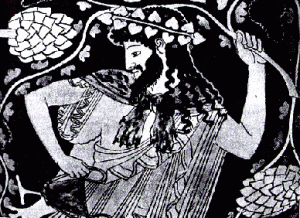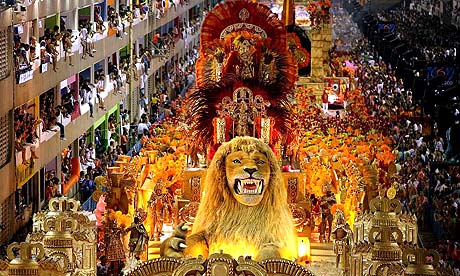THE CARNIVAL
An ancient Greek event
HISTORY OF THE CARNIVAL
The origins of Carnival can be tracked centuries back to Greek celebration honoring the God of Wine Dionysus. This festival influenced the creation of Bacchanalia, a tribute to Bacchus, the Roman equivalent to Dionysus. Inspired, the Saturnalia fête developed (Saturnalia literally translates into excess of the senses) leading to the Catholic Church using the fiesta as a lead up to Lent. All of these festivities contribute to the present day event we know as Carnival, a yearly celebration of the joy of life.
PONTIAN CARNIVAL
Momom was the god of jokes, Momos' son of dream and night (Hypnos and Nyx), he was the god of madness, he used to do jokes and he used also to make fun of people. He provides diversion to other gods in Olympus. Momos is the name of the god of mockery in Greek mythology, and according to Carnival tradition, King Momo should be jolly and as big as a house. In tribute to King Momo, the King of the Carnaval, people join in merry-making revelry as they prepare to begin abstinence throughout the 40 days of Lent. The Pontians celebrate this event at 12 day Perios between Chistmas and Epiphany.
Momo'eron I shall be and during the nights being naughty I wil hunt for girls
Instrumental (gaida and drums)
SATYRIC NAUGHTY SONGS The traditional carnivals of Greek Macedonia prove us that there is continuation between ancient and new Greece. Dionysiac celebrations.
People masquerade with pelts and bells, singing satyrical poems and songs. Just like thousands years before. The spirit of ancient Greece is still living in Macedonia. SATYRIC NAUGHTY SONGS

SOCHOS, THESSALONIKI GREECE
Sochos, this small market town some forty miles
northeast of Thessaloniki , Greek Macedonia, is renowned for its carnival. The chief
character is the carnival [karnavali], dressed in a goatskin shirt and leggings, a tall conical hat covered in multi-coloured streamers, known as the kalpak, a sequined mask with a long horse-hair moustache sewn onto it, and five heavy bells hanging from his girdle.
EVENT FROM THE OLYMPIC GAMES

Click above
As early as January, celebrants wearing bells begin to appear in the kafenions,
where the men sing special songs. However, during the last week of Carnival they don full costume and roam the streets with bottles of
ouzo, which they offer to friends, relatives and passers-by, while performing a circular dance and sounding their bells.
There is a mystery about the carnival at Sochos. It is known that the masked figures originally appeared not during the pre-Lenten Carnival period, but on the feast of Saint Theodore, on the weekend after Clean Monday, and during the Lenten fast. Local people charge a Church hostile to pagan survivals for the change of date.FEAST AT THE SOCHOS SQUARE

In the recent change of the date of this celebration we can see part of the process by which the Church "tamed" pagan festivities, so as to avoid breach of the Lenten fast, and so as to harmonise, as well as possible with the
Christian calendar. We may suppose this to be something which had happened in many other places at an earlier date. It also helps explain why festivities which take place today, and which have pagan origins,
may take place in different places at different times.
NAOUSSA CARNIVAL
During the days of Carnival, townspeople relive the traditional custom called Boulas and that of the Janissary-Genitsaros. There is a parade
with traditional and satirical costumes. The history of the dance group, goes back to 1705. In that year people of Naoussa, honored the
memory of their young fellow-citizens, who fell in the struggle against the Turks. They appear during Carnival dressed in the uniforms of the freedom-fighters with wax masks and breastplates made out of thousands of silver coins. The costumes, the music and the dances are all authentic and have been handed down from generation to generation without any modern influences. The dance troupes, accompanied by the town band, dance in the streets and in many of the taverns, where they
are treated to the local wine, apples and other things to eat. These events begin in the morning and last until late at night.

Click above
PATRAS CARNIVAL
Modern Greek Latino Carnival. The Patras Carnival, Patrino karnavali is the largest event of its kind
in Greece and the biggest in Europe. It has more than 160 years of history. The events begin on 17 January and last up to Clean Monday. The carnival of Patras is not a single event but a variety of events that includes balls, parades, hunting of hidden treasure, kids carnival etc. Its apogee is in the last weekend of Carnival with the Saturday evening parade of carnival groups, the extravagant Sunday parade of floats and groups, and finally the ritual burning of king carnival at
the St. Nikolaos Street wharf in the harbour of Patras. Its characteristics are spontaneity, improvisation, inspiration and
volunteerism.
GREECE MOST POPULAR CARNIVAL - LATINOGENIC
Click above
RIO BRAZIL CARNEVAL
In tribute to King Momo, the King of the Carnaval, people join in merry-making revelry as they prepare to begin abstinence throughout the
40 days of Lent. The roots of the Carnival can be traced back to 1723 when settlers from the Portuguese Islands initiated the Entrudo, a
street game of water, mud, and food tossing which involved everyone in the city. In 1840, the first of the balls took place - a masquerade ball where dancing to polka and waltzes kept people moving throughout the event. Street parades became part of the festivities about ten years later, leading to the samba (a fusion of European, African, and
Cuban music) merging into the familiar sounds of Carnival by 1917. In 1928, the Samba School surfaced as part of the Carnival culture
influencing the founding of Samba Parade held in the streets of Rio. The Sambodromo was built in 1984 to house the parade. You can hear the passion of the Carnival beating during Carnival Sunday and Monday. One
more element of Carnival is the balls or dances, originated in Italy, taking on various shapes from the public Cinelandia Ball to the lavish Gala Ball.
RIO CARNIVAL
Click above
Being part of Carnival, past or present, provides an opportunity for all to celebrate together - young, old, rich, poor. In ancient times, the Saturnalia Gala included a chance for the masters and slaves to trade clothes and positions, attempting to understand each other's life and, for a day, come together as equals. Currently, the joining of people is witnessed in the neighborhood parades, public balls, and
Samba Schools.
ENJOY A PRESENTATION BY GEORGIOS
Happy Week End